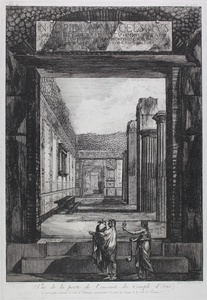| Method | Etching |
| Artist | Francesco Piranesi |
| Published | Dessine par J.B. Piranesi. Grave par F. Piranesi L'an 13 (1805 |
| Dimensions | Image 680 x 485 mm, Plate 730 x 510 mm, Sheet 795 x 590 mm |
| Notes |
A view of the entrance to the Temple of Isis at Pompeii, Plate 61 from Volume 2 of Francesco Piranesi's Antiquites de Pompeia, part of his Antiquités de la Grande Grèce. The scene is an unusual pastiche of ancient and modern. The building behind is shown in ruins, as it appeared at the time of Piranesi's visits to the city in the 1770s, but the two figures in the foreground are from the Roman era, a priest with his toga pulled up over his head who holds a large urn or situla, and a priestess with her chiton tied up in an Isis knot holding out a sistrum and a simpulum. The large Latin inscription shown at the top of the scene is now in the Naples Archaeological Museum, but was originally situated above the entranceway to the precinct of the Temple of Isis, which filled a space between the Triangular Forum and the Large Theatre, near the Stabian gate. Beyond the doorway, the stuccoed decorations of the outer collonade and the purgatorium can be seen. The inscription itself recognised the refurbishment and rebuilding of the Iseum after the earthquake of AD 62 by the father of a six year old boy called Numerius Popidius Celsinus. The boy's father, N. Popidius Ampliatus, was a freedman and thus barred from holding political positions in the city, though the rebuilding program was enough to elevate his son. A French inscription below the title reads 'on voit la partie interieure de l'aile de l'Atrium correspondante a la porte du Temple de la Ville de Pompeia,' and the date of the plate is given in both the Revolutionary and Gregorian calendars. The Antiquités de la Grande Grèce was published in the early years of the nineteenth century, but was most likely inspired by two visits to Paestum, Pompeii, and Herculaneum undertaken by Francesco Piranesi with his father in 1770 and 1778. Giovanni Battista Piranesi had prepared a number of preparatory sketches of the temples of Pompeii and Paestum that were eventually engraved and published by Francesco, but the remaining plates for the three volumes of the Antiquités seem to have been of Francesco's invention. Although lacking some of the romanticism of his father's earlier plates of Rome, the illustrations from the Antiquités nevertheless provide a valuable record of progress in the archaeological exploration of the sites of the Neapolitan region, and are testament to Francesco's deep engagement with Roman antiquity. Francesco Piranesi (c.1756-1810) was an Italian engraver, etcher and architect who mainly worked in Paris. He was the eldest son of the famous etcher Giovanni Battista Piranesi (1720-1778), under whom he studied printmaking and architecture. By 1775, Piranesi was both producing his own work and assisting with his father's. Upon the death of Giovanni Piranesi three years later, he inherited his father's publishing house and was responsible for producing most of the later editions of his prints. In 1798, Piranesi moved to Paris, where he was later employed by Napolean, to engrave classical sculpture and vase collections within France and French-occupied Italy. He also collaborated with the French artist Louis-Jean Desprez (c.1743-1804) on a series of Italian views which were sold at Piranesi's shop in Rome. Although the 1783 advertisement for the series promised forty-eight views, the series was not completed before Desprez left Rome to become Director of Scenic Decorations at the Stockholm Opera. Piranesi died in Paris from syphilis in 1810. Condition: Strong dark impression with full margins. Marginal creasing and ink-staining. Some repaired paper splitting to platemarks. |
| Framing | unmounted |
| Price | £700.00 |
| Stock ID | 50726 |

